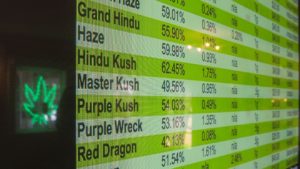That drug, man… it, like, uh, really ties the artificially intelligent, automated greenhouse together… you know?
“I’m the Dude, so that’s what you call me. That or, uh, His Dudeness, or, uh, Duder, or El Duderino, if you’re not into the whole brevity thing.”
Dope, weed, grass, cannabis, marijuana, or even pot – if, like Hollywood superstar Jeff Bridges, you live in the 1970s and make classic stoner films like The Big Lebowski.
There are hundreds of words for what is probably the most widely used recreational drug in the world. It’s still illegal in much of the world, but some states in the US have taken what many see as an enlightened view and decided they would rather not spoil someone else’s rug, or take it away.

At least five states in the US have legalised marijuana for medical and recreational use:
- Alaska;
- Washington;
- Oregon;
- Colorado; and
- Hawaii.
Around 20 states have legalised marijuana for medical use. They include:
- California;
- Nevada;
- Arizona;
- New Mexico;
- Montana;
- Minnesota;
- Michigan;
- Illinois;
- Louisiana;
- Maryland;
- Delaware;
- New Jersey;
- Pennsylvania;
- New York;
- Connecticut;
- Rhode Island;
- Massachusetts;
- Vermont;
- New Hampshire; and
- Maine.
That’s a lot of states where you can legally deal dope, covering almost half the country and probably 100 million people. In other words, a massive market.
The information for the lists above was collated by Governing.com, which points out that there are states where it’s a little more complicated. But then, when you’re stoned, everything’s complicated.
“Yeah, well, you know, that’s just, like, your opinion, man.”

There was a point to this article, and it’s a good job we’ve got it written down – our short-term memory isn’t what it used be at the start of this sentence. Artificial intelligence and automated greenhouses…
The size of the market in the US for cannabis has always provided for a massive, largely hidden economy for drug dealers. But with so many states allowing “the devil’s weed” to be openly traded, some international cannabis outfits are going legit.
One of them, Canadian company Aurora Cannabis, has just broken ground on what it says will be “the world’s largest, most advanced and most automated cannabis production facility in the world”, located in Alberta, Canada.
When completed, Aurora’s new hybrid greenhouse facility – Aurora Sky – will measure 800,000 square feet, a footprint larger than 16 football fields.
Situated on 30 acres of leased land in Leduc County, Alberta, Aurora Sky is forecast to be capable of producing in excess of 100,000 kilograms of “high quality, low cost cannabis” per year. The location of the new facility provides unrivalled access to transportation, industrial infrastructure, power, water, gas, and courier services, says the company.
Aurora currently operates a 55,200 square foot purpose-built facility in Mountain View County, Alberta, and has selected a closed-system, hybrid greenhouse concept of Dutch design for the expansion.
The new system will give Aurora’s cultivation specialists “precision control” over all critical environmental variables to ensure production quality is consistent with the Aurora Standard, says the company.
The company adds that the high level of automation at the Aurora Sky facility will provide for ultra-low per-gram cost of production.
In addition, the modular nature of the design will allow for a rapid construction process, minimizing the risk of potential delays, with completion of the new facility targeted for October of 2017. Construction of the facility’s pre-engineered structure has been under way in the Netherlands since October, 2016.
Steve Dobler, president of Aurora, says: “Our objectives are very clear: to build the largest production capacity, with the highest production quality and the lowest production cost.
“We spent the past year evaluating and selecting the world’s best design concept for cannabis production on a massive scale. We are confident that the Aurora Sky project will achieve all of our key objectives, and further establish Aurora as an innovator and world leader in the cannabis sector.”
Aurora says the new facility will feature a number of advanced automation technologies, including:
- Forced air, bottom-fed positive pressure grow facility with supplemental sun through a specialized glass roof, optimizing micromole levels for cannabis health and yield.
- The latest in anti-reflective and diffusion glass technologies resulting in greatly reduced fan leaf shadows.
- Meticulously placed glass in a four-sided rubber gasket system, minimizing heat and CO2 loss, while eliminating odor escape.
- Self-cleaning glass with snow melt technology, providing 365-day optimum supplemental sun.
- All steel in facility will be white powder coated for maximum reflection and GMP [good manufacturing practice] compliant cleanliness.
- A separated condensation system to remove humidity issues common to cannabis growth.
- Exterior walls with the optimum combination of insulation and light penetration.
- Rainwater harvest and full re-use technology with the latest UV and mechanical filtration technology.
- Unique heating and cooling systems for climate uniformity, which balance temperature, air flow and humidity to avoid vapour pressure deficits.
- Double, self-adjusting, wire driven screens for maximum energy savings, plant protection and “99.9 per cent” effective blackout.
- Highly flexible, component-based, multiple-stage water filtration, irrigation and nutrient delivery with full recirculation and cultivar-specific feeding systems.
- Electronic, automated climate control.
- Full “seed-to-sale” tracking systems.
- Fully automated, mobile platform growing system ensuring plants are positioned optimally for climate, irrigation, light, and growth at all stages.
- Deployment of cranes and conveyors throughout the facility, providing efficiency and a safe work environment for employees.
- Latest lighting technology with hybrid HPS and LED installation.
- Establishment of the “world’s first” industrial scale plant tissue culture process specific to cannabis.
“That rug really tied the room together.”

Meanwhile, in Colorado, in the US, a tech startup called Grownetics is busy installing its third system at Green Dream Cannabis, a research and development cultivation facility managed by Shift Cannabis, a consultancy and management firm for boutique, or smaller-scale, cannabis cultivation.
Grownetics says it combines hardware, software, and artificial intelligence to offer cannabis cultivators “the most complete management and optimization solution on the market”.
Grownetics says it surpassed $400,000 in sales within a year of incorporating, and continues to move quickly. It claims that the first two facilities are seeing “unprecedented savings” of 60 per cent in operational costs while also increasing yields.
Eli Duffy, CEO of Grownetics, says: “We’ve not only been breaking our revenue projections to this date, but the savings our customers are experiencing are higher than anyone else is seeing. Now we can’t wait to take this advanced technology and establish ourselves as the most advanced system within the indoor greenhouse agricultural market.”
Grownetics says its system has been described as the “self-driving car” for agriculture, adding that its “fully automated garden system” is poised to be the leader in automation and machine learning for both cannabis and indoor agriculture as a whole.
“Is this a… what day is this?”

Another startup company – this one based in Sacramento, California – also apparently doing well in the fast-growing cannabis market is Zerez, which provides commercial greenhouse and automation systems.
Zerez, too, aims at the smaller-scale cannabis grower, and recently sold one of its greenhouse systems for approximately $181,000. Operating through its subsidiary, Next Generation Farming, Zerez says it plans to use the solution for both organic farming and legal cannabis cultivation.
Zerez president John Taylor says the early success is down to “consistent communication with our clients and with our various manufacturers”, while the company’s vice-president, Don Smith, adds that the new sale “reinforces our credibility as the experienced company to work with if you are serious about smart technology automated greenhouses for organic food production or cannabis cultivation”.
Zerez has also signed a strategic sales and marketing agreement – through Next Generation – with Sweet Leaf Hydro the company itself values at “over $1 million”.
Taylor says Sweet Leaf is “the most capable, most reputable company in the California Central Valley”, and that Zerez’s “advanced automated greenhouse line of products, proprietary automation systems and various accessories needs key strategic partners to fully implement our business plan to dominate the west coast in brand recognition”.
Jay Desalvatore, president of Sweet Leaf Hydroponics, says Next Generation is offering an “affordable product line, and state of the art software control system” which will be critical in multi-location operations.
Altogether, Zerez claims it has earned ¢900,000 in revenues in its first 30 days since it emerged from stealth mode.
The company says it is still finalising its proprietary “Made in the USA” line of smart greenhouse products, automation software control systems and accessories being marketed and sold to the explosive organic food and cannabis cultivation industries.
Smith says: “These markets are growing so fast that even the expert industry research firms cannot pin down a realistic market size or rate of growth.
“We conservatively estimate the smart greenhouse market size at $6 billion in 2017, and the organic farming and cannabis sector are realistically immeasurable, meaning they are growing off the traditional growth rate charts.
“It’s likely that real serious companies in this market with competent management teams, strong product lines, and profitable operations will grow thousands of percent in the next few years. We happen to believe that we have assembled that exact combination and plan to be among the market leaders in both market segments.”
“This is a very complicated case, Maude. You know, a lotta ins, a lotta outs, lotta what-have-yous.”

Meanwhile, across the Atlantic, in what is one of the world’s most dopey nations, Netherlands, a company called Mark Climate Technology has been demonstrating new technology for keeping birds and even perhaps The Big Lebowski away from rugs.
MCT has provided the new building of De Plantenhal, located in Rhoon, with what it calls “Infra Aqua Design” radiant panels.
The Infra Aqua Design is a water-fed aluminium radiant panel that heats a room without any draughts or displacement of air or dust. The panel also produces very little noise, which is a plus for the retail spaces of the garden centre.
The customer has specifically chosen a radiant panel with PUR [polyurethane] hard foam insulation, finished with an aluminium foil layer. “As a result, there is less chance of damage to the insulation by birds and at the same time the panel has a very good heat transfer,” says the company.
MCT claims that the heat distribution only takes place where it is required, and that due to the short heating period of the radiant panels and the lower required room temperature a higher energy saving can be achieved.
In addition, the Infra Aqua Design radiant panels were chosen because they are flat, lightweight and very compact. Moreover, because of the white coating, they discreetly provide the right heat for all the greenery, says the company.
“Mind if I do a J?”

